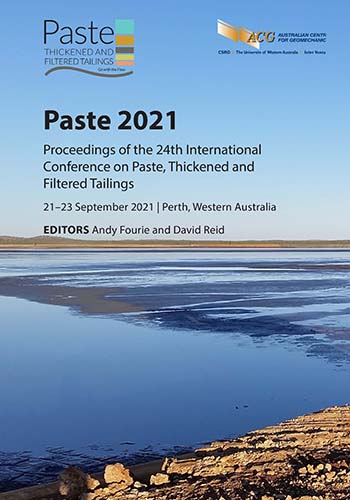Operational optimisation of a tailings storage facility based on statistical analysis of historical monitoring records

|
Authors: Ezama, I; Pastine, S; Pinheiro, J |
DOI https://doi.org/10.36487/ACG_repo/2115_26
Cite As:
Ezama, I, Pastine, S & Pinheiro, J 2021, 'Operational optimisation of a tailings storage facility based on statistical analysis of historical monitoring records', in AB Fourie & D Reid (eds), Paste 2021: Proceedings of the 24th International Conference on Paste, Thickened and Filtered Tailings, Australian Centre for Geomechanics, Perth, pp. 315-324, https://doi.org/10.36487/ACG_repo/2115_26
Abstract:
Operational control and trigger action response plans for tailings storage facilities (TSFs) routinely measure a number of operational aspects to assess risk and ensure the TSF does not exceed certain design considerations. Measurements that are routinely used for this purpose include topographical surveys and beacon settlements, density and moisture measurements, and discharge characteristics, among others. A statistical analysis of the cumulative historical operational datasets from a TSF allows improved knowledge of the level of variability of the considered parameters, and potentially enhances risk-based decisionmaking by increasing the understanding of uncertainties and the potential for expected deviations during operations (ICMM 2021). The inclusion of a probabilistic dataset in the design inputs allows a performance-based approach to managing a TSF, considering a series of scenarios defined by performance objectives, determining key factors to identify them in a timely manner, and incorporating effective corrective or ‘failure’ control measurements, that can be improved with sequential forecasts of the TSF behaviour. This approach was undertaken to optimise the deposition strategy of the Cerro Vanguardia TSF and expand its life-of-mine (LOM), allowing for tighter construction planning and deferral of construction by several years. This had considerable benefits during the current COVID-19 contingency. Statistical analysis of ongoing operational monitoring data was adequately incorporated into operational design optimisation and to select an adequate level of risk tolerance based on an ‘as low as reasonably practical’ (ALARP) perspective. Performance-based scenarios were identified and plans for timely decisionmaking were established to forecast reasonable economical/financial planning, and a probability-based events selection to trigger timely operational adjustments.
Keywords: tailings storage facility, tailings beach, deposition strategy, operational design, probabilistic riskbased approach
References:
Australian National Committee on Large Dams 2012, Guidelines on Tailings Dams – Planning, Design, Construction, Operation and Closure, Australian National Committee on Large Dams, Hobart.
Efron, B 1993, An Introduction to the Bootstrap, Chapman & Hall, Boca Raton.
q5qgFor46Fgs/
International Council on Mining & Metals 2021, Tailings Management - Good Practice Guide, International Council on Mining & Metals, London, viewed 10 August 2021,
2021/guidance_tailings-management.pdf
© Copyright 2026, Australian Centre for Geomechanics (ACG), The University of Western Australia. All rights reserved.
View copyright/legal information
Please direct any queries or error reports to repository-acg@uwa.edu.au
View copyright/legal information
Please direct any queries or error reports to repository-acg@uwa.edu.au





